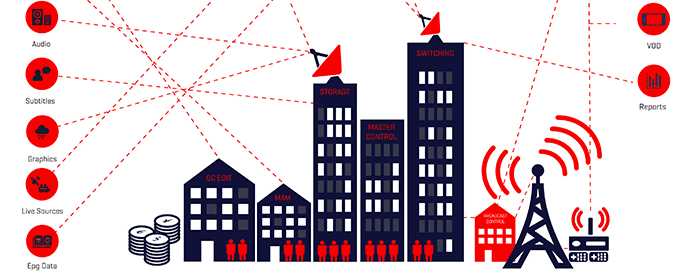M+E Exclusive

Deluxe MediaCloud CTO Talks ‘Industry-First’ 4K Delivery Test
Story Highlights
ATSC 3.0, virtual reality, high dynamic range (HDR) … all look to be big newsmakers during April’s NAB Show. But as far as the run-up to the annual trade event in Las Vegas, it might be Deluxe Entertainment Services Group’s 4K delivery news most worthy of headlines.
On March 29, Deluxe announced it had successfully delivered a live, 4K-resolution video broadcast between London and Los Angeles, using only the Internet infrastructure available to the public. It may only be in the testing phase, but Deluxe believes the technology could be transformative for content distributors, a new way to offer real-time, 4K delivery on a worldwide basis.
Alec Stichbury, chief technology officer for Deluxe MediaCloud, chatted with the Media & Entertainment Services Alliance (MESA) about the challenges of delivering 4K video over the public Internet, and the potential use-cases for the technology.
MESA: What made this 4K test stand out compared to other forms of live 4K content delivery?
Stichbury: This test was delivered entirely across the public Internet. Using two discrete ISPs we were able to send a total payload of 106 Mbps, split evenly at the pitching site and combined back at the receiver site. This was done with less than 12 frames of latency end-to-end, with no drops and secured using AES-256 encryption. A truly unique feat.
MESA: What were some of the technical challenges Deluxe encountered?
Stichbury: Interestingly the challenges were not around the areas you would expect, such as networking components of the test, [an] element [that] has been well soak-tested over the past three years. The biggest challenges were sourcing the hardware to support the HEVC [High Efficiency Video Coding] encoding requirements and the 12G decoder card, display to output and view the received pictures. It is often the case that the simple things trip you up the most.
MESA: How can content distributors use this to their advantage?
Stichbury: A number of methods spring immediately to mind:
Real-time signal distribution is often the fastest, most convenient and only way to get high quality video from point A to point B;
The highest quality, real-time, live theatrical broadcasts;
Sports producers can deliver the highest quality signals, in the fastest, most secure manner;
Outside broadcasters can use IP to manage signals within the truck and send higher quality signals out across lower grade network points with 100% peace of mind.
IP distribution is the most flexible way for a distributor to retain control of its properties through feedback loop monitoring both video and data analytics, every step of the way.
MESA: Are there concerns over bandwidth and latency when it comes to delivering 4K in this way?
Stichbury: Our exclusive load balancing capability allows us to transmit live video across up to eight discrete ISPs, [giving us the ability to] manage the bandwidth utilization across each individual ISP. Therefore, we can manage traffic across more intolerant links and during peak times. Of course, our preference is to utilize discrete tier one carriers. In recent live production comparisons, we have delivered signals 1.5 seconds faster than the equivalent satellite infrastructure. This offers tangible benefits to the distributors, to news agencies and any broadcaster receiving live International feeds.
MESA: What’s next for Deluxe and this delivery model?
Stichbury: At NAB [in April] we will be demonstrating a software-only encoder/decoder capable of HD, 2K, 4K and even 8K, at any bit-rate. This is integrated seamlessly with our low latency, high quality H.264 yellow label software encoder/decoder with full Dolby support. With our load balancing and multi-pathing capabilities, we deliver greater resiliency than MPLS (multiprotocol label switching)-based carriage, so our intention is to continue to build out our global broadcast delivery network community.









